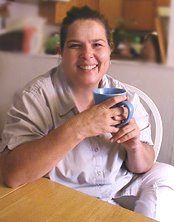 Seems kind of silly, but after posting yesterday I realized I wasn't entirely sure what a kWh was. I gave myself some basic schooling today.
Seems kind of silly, but after posting yesterday I realized I wasn't entirely sure what a kWh was. I gave myself some basic schooling today.A watt is the unit electric appliances and utility providers measure electricity usage. A kilowatt is 1,000 watts. A kilowatt hour is the same thing as a kilowatt. How are they different? Um, I don't think they are.
For my purposes, I need only understand the electric company bills me in 1000 increments, those kWh thingies.
Today I took a little tour around my house, paying special attention to items I use most often. Every appliance has their wattage listed on the back. I found one that immediately seemed like a real guzzler -- my coffee machine, listed at 900 watts. What that means is if I leave it on for an hour it will use 900 watts. Or, in the parlance of my electric bill, .9 kWh.
Holy beans, Mr. Coffee! I make coffee every day and leave the pot on for at least an hour. (Do not get between me and the coffee pot in the morning.) That means in a month I use 27 watts (.9 X 30 days) . Sure, that's only $3.30 a month, a pittance compared to Starbucking it. But here's a real kicker for me: it was 10% of my electric usage last month.
Here's another kicker that can be applied to us all: each kWh saved is almost half a kg shaved off your carbon footprint. (See "It's carbon judgment day" on Guardian.co.uk for detailed information on how to calculate your carbon footprint.)
With my mom's help (she's very smart and has done a lot to reduce), I've got a painless solution to save most of those coffee kWhs and most of the 11.61 kg of CO2 I would otherwise emit monthly. After my coffee makes tomorrow, I'm pouring it into a thermos and turning off the pot.
Which makes me think of the refrain, "How low can you go? How low can you go?"
UPDATE: Read Eeyore's comment for an engineer's calm explanation of why I might have over-demonized my coffee pot. Thanks, Larry!
Photo is your author, with my gotta-have-it jo, August 2006.



6 comments:
Holey moley! My coffee pot is on for two hours before it shuts itself off. I've never even considered how much energy that uses!
Don't be that alarmed. The 900 watts is only being used during the brew cycle. Once that is over and the pot switches to the keep warm mode, the energy consumption goes way down. If it was still pumping 900 watss into the coffee, it would boil dry in just a little while.
I'm an engineer and I'll try to walk you through some of it when I've got a little more time, but I've gotta run right now.
Never mind. Pouring the coffee into a thermos pot makes the coffee taste better longer anyway. We've been doing it in Europe for quite a long time. That is, if we aren't using our energy wasting Senseo machines. I'm sure I'm going to hear about that.
I think it does taste better longer if you pour it into a thermos instead of the slow cooking it continues to receive even on the lower powered warmer.
Thank you everyone for your comments. A special thanks to Eeyore for demystifying the Watt rating.
I've gone a few days now with turning off the pot after it makes. And I've not suffered one bit.
I didn't have a thermos after all, but instead am using one of those large travel mugs.
Mmmmm, coffeeeeeee.
I've just read all of the posts on this page in an effort to catch up with all of the fabulous things you are doing. Way to go Debi! I am so happy to read what you've been sharing! Obviously I can't comment on every post but I will be back to check out some of these links. I am commenting on this post because I recently did the math work out for my jug. It costs me 10c a boil which sounds like a pittance...but I easily boil the jug 10 x a day. So a $1 a day over a month means my jug boiling is actually costing us $30 a month on the power bill. I don't know what that costs the earth but even the realisation of what it cost my pocket was a shocker! I was one of those people who might boil the jug 2 or 3 times before atually getting around to making the coffee but now I am much more aware of that cost. The cost of having the TV on for 6 hours a day (and that's not hard when the family takes turns at watching what they want to see...) was also surprising...and that was without the lights being on! It certainly pays to keep on eye on the sneaky energy consuming things we do each day, money aside these things could cost us dearly!
Post a Comment